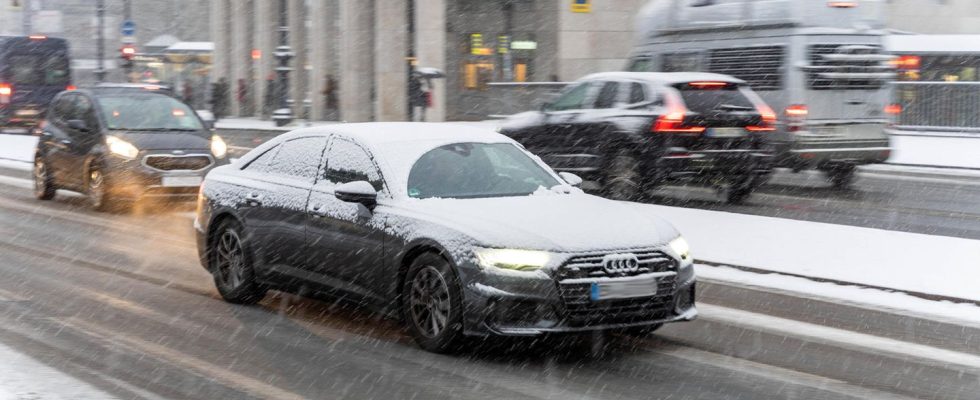In winter, the risk of car accidents increases significantly. Driving is particularly dangerous in snow, slippery conditions and fog. That’s why it’s important to behave correctly. What drivers should know.
The German Weather Service (DWD) is currently warning (as of Monday morning) of freezing rain and black ice in Germany. A warm front from a low causes slippery conditions across much of the country. In the Ore Mountains there are also warnings about slippery snow and snowdrifts.
Drivers should therefore adapt their driving behavior to winter conditions and drive particularly carefully. Snow, black ice and fog significantly increase the risk of an accident.

Watch the video: After a warm front – black ice paralyzes traffic in parts of Germany.
If it is snowy or slippery: prepare the vehicle for travel
You should first adapt your vehicle to the winter conditions. The right tires are important here. In addition to winter tires, all-season tires marked “M+S” can also be used under certain conditions. It should be noted that not all tires with the “M+S” symbol are real winter tires. Since 2018, winter tires have had to bear the Alpine symbol. Exception: If “M+S” tires were manufactured before December 31, 2017, they can still be used until September 30, 2024.
Winter tires should be a maximum of eight years old. In addition, the tread depth is crucial. The legal requirement is 1.6 millimeters, but ADAC Saxony recommends a tread depth of at least four millimeters.
“Once the winter wheels are on, that’s only half the battle,” says Thomas Kubin, technician at ADAC Sachsen. In addition to winter tires, the vehicle as a whole must be prepared for slippery and snowy roads. It is advisable to have an ice scraper, hand broom and cover film for the windshield in the car. The windshield wipers should also be protected from freezing so that they are not damaged when they come off. The fluid levels should also be checked. The windshield wiper system should always be equipped with sufficient antifreeze be filled up, explains the ADAC when asked star.
Before driving, the vehicle windows must be completely cleared of ice and snow. The same applies to the vehicle roof. According to the ADAC, anyone who only drives with a “peephole” in the window risks an accident. And: “In the event of a crash, there is a risk of shared liability.” If the vehicle windows and roof are not completely cleared, TÜV Nord points out that there is a risk of a fine. A point in Flensburg is also possible.
The ACE automobile club recommends that you check the vehicle lighting to ensure it is functioning properly and is set correctly. Headlights that are set too high would not only dazzle oncoming traffic, but also reduce your own visibility. The ACE also advises: “In addition to the windshield, regularly clean the exterior mirrors, indicators, other lights and all other windows.”
In order to prepare the vehicle for the journey immediately in advance, some people let the engine warm up. But the ADAC strongly advises against this. This increases fuel consumption enormously and at the same time harms the environment. In addition, engine wear increases significantly. And there is a risk of a fine of 80 euros.
ADAC recommends turning on low beam headlights even during the day
When visibility is poor, the question of appropriate lighting also arises. There is no legal regulation as to when drivers must drive with daytime running lights. However, for your own visibility, the ADAC recommends always using it. “In autumn and winter, daytime running lights are usually not enough because visibility is often poor during the day and the lights are only at the front of the vehicle.”
However, in difficult visibility conditions and possibly fog or snowfall, low beam headlights and optionally fog lights are also required during the day. The ADAC explains: “They are helpful because they spread the light flat over the road and thus illuminate it better.” As soon as visibility improves, the fog lights have to be switched off again or switched to low beam. Fog lights could be used in addition to low beams or instead.
They should not be confused with the rear fog lights. This can only be switched on when visibility through fog is less than 50 meters. Then a maximum speed of 50 km/h also applies. The same applies to snowfall. To determine this distance, the ADAC recommends paying attention to the distance between the guide posts on the side of the road on country roads and motorways. Because it is exactly 50 meters.
In winter the following applies: “Drive with foresight and caution”
In winter you always have to be particularly careful on the roads. According to the ADAC, there is no magic formula for driving in ice, snow and winter wet conditions. “Driving with foresight and caution is the be-all and end-all.” You should adapt your speed to the weather conditions and keep enough distance from the vehicle in front. The braking distance on snow-covered roads is up to five times longer than on dry roads. And this is where the difference between summer and winter tires becomes clear: If you need around 25 to 35 meters to bring your vehicle to a standstill at a speed of 50 km/h with winter tires, it takes 50 to 70 meters with summer tires.
The ADAC recommends doing a short brake test on an open road, provided there is no danger to others. This gives you a feel for the winter journey.
The basic rule is: “brake gently and steer carefully”. The risk of losing control of the vehicle is higher than on dry roads. If the road is slippery, it is also advisable to drive at low speed. Driving in high gear makes the journey easier because the tires grip the road better. For this reason, it is advisable to start off in second gear when it is slippery.
If you get into a skid while driving, you should take the gear out of gear, brake and countersteer quickly but with feeling. The Electronic Stability Program (ESP) supports vehicle control. If the vehicle no longer reacts, the only option left is to brake hard. If the vehicle leaves the road in a curve, you should under no circumstances react hectically. Instead, the ADAC advises stepping on the brake pedal “firmly and sustainably”. If you reduce the speed by a few km/h, this usually helps to regain control of the vehicle.

A traffic sign warns of slippery snow or ice. There are not always signs pointing out the danger.
© Wolfgang Maria Weber / Imago Images
Lightning ice – the special danger
Lightning ice makes driving particularly dangerous in winter. It occurs when supercooled rain or fog spontaneously freezes on the road. However, lightning ice can also occur if the droplets are not supercooled, but they hit supercooled objects or supercooled ground.
The ADAC warns: “There are not signs pointing out the danger everywhere. The tricky thing about freezing water is that the layer of ice is barely visible and appears suddenly.” But how can you recognize the impending danger of lightning ice? According to the automobile club, it mainly occurs in shady places such as forests or on bridges, where the road surface is particularly exposed to the weather. Accordingly, fog and hoarfrost on trees could indicate lightning ice. Winter tires, anti-lock braking systems (ABS), ESP or even chains would not help against lightning ice.
If lightning ice occurs while driving, you should take a break and wait for the road service. The ADAC warns that the adhesion between the tires and the road is zero. If you are warned about lightning ice or freezing rain, you should, if possible, not start the journey at all and leave the car parked.
The power of the winter sun
No winter lasts forever. An invitation to pause in three images


